Here’s one I made earlier.
Well what are you going to do? At nine o’clock this morning it is pitchy black outside and pelting down with rain. Two hours ago I had an intense debate with myself about whether Dogs really need to eat “every” day. I am supposed to be looking after Fizz while her owners are away.
Don’t worry I fed her but I needed wellies and a hat to get from my door to hers (and I sat with her and played with her).
What do you think that this is?
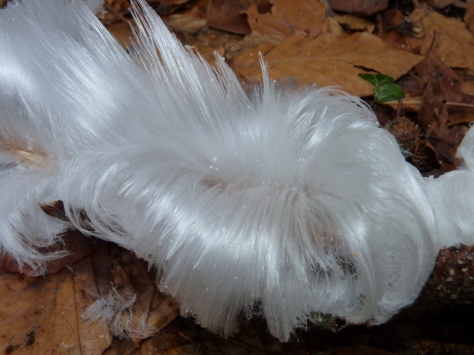 I must admit that when I first saw and photographed this I thought it was some kind of fungi that I hadn’t seen before. (there are lots of those)
I must admit that when I first saw and photographed this I thought it was some kind of fungi that I hadn’t seen before. (there are lots of those)
I will give you a clue. I took these pictures whilst on holiday on Dartmoor it was January and it was very cold.
 This is called Hair Ice or Haareis. It is ice being forced out of tiny pores in the wood but it might be a fungus still…
This is called Hair Ice or Haareis. It is ice being forced out of tiny pores in the wood but it might be a fungus still…
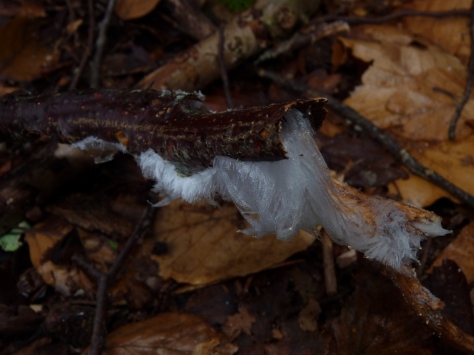 The Swiss seem to be the leaders in Haareis research with Dr Gerhart Wagner being at the forefront. There is a 38 page paper “Enlightening the Mystery of Hair Ice,” published in 2012 and available from Bern University which I haven’t read but apparently it concludes that in every example of Hair Ice that they studied there was also a fungus present which may have triggered the phenomenon.
The Swiss seem to be the leaders in Haareis research with Dr Gerhart Wagner being at the forefront. There is a 38 page paper “Enlightening the Mystery of Hair Ice,” published in 2012 and available from Bern University which I haven’t read but apparently it concludes that in every example of Hair Ice that they studied there was also a fungus present which may have triggered the phenomenon.
Dr Wagner has also made this extremely enlightening video which is in German and unfortunately I can not understand a word of it.
Many, most, all of my readers are smarter than me and so I have included it so that you may find out as much as you want.
Whatever it is (it is water) Hair Ice is beautiful and natural and I photographed it so it deserves a post.
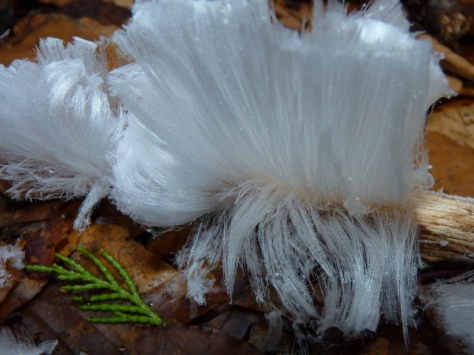

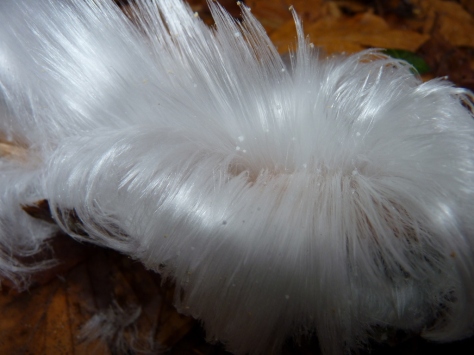

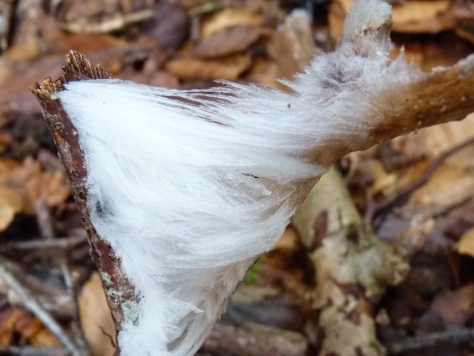
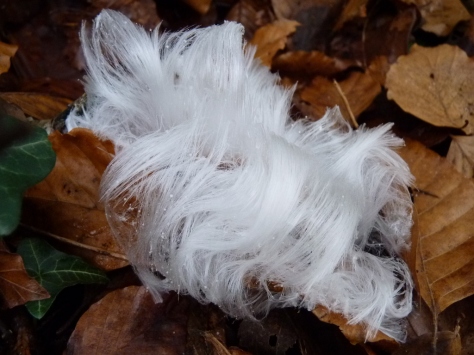

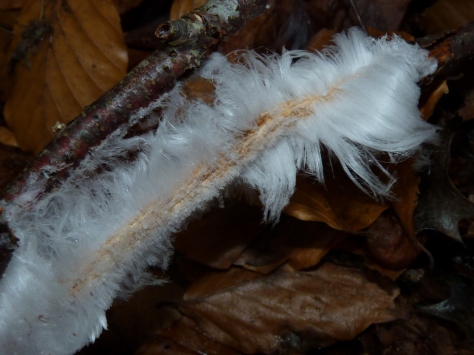
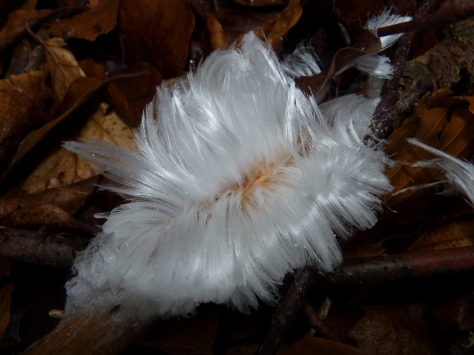
Absolutely wonderful. Isn’t the natural world awesome and a thing of amazing beauty.
LikeLike
Thank you John 🙂 It surprises me every day.
LikeLike
you are so very lucky i’ve always wanted to see this in person! As I understand it the plants individual xylery cells (dead cells at maturity that ensure water uptake and transport throughout the plant stem) can no longer resist the water vapor deficit in the outside atmosphere (xylem works via negative pressure…basically the dry air sucks the water from the leaves and the leaves from the stem and the stem from the roots and the roots from the more wet soil). Since the tension gives way the water comes streaming out of the very thin xylem vessels “tubes” forming these. I could be wrong but that’s what I get out of the phenomena. The fungi trigger is new to me, but something as simple as an air bubble can break the cohesive water tension in these vessels so why not.
LikeLiked by 1 person
Thanks for that explanation 🙂 That does make sense.It seems to be an area that we don’t know an awful lot about. Even the 2012 paper mentioned above noted the presence of the fungus in every case but would not commit to saying that the fungus was a necessary factor or the only factor. After decades of study they don’t fully understand it 🙂
LikeLike
of course you need freezing cold air to immediately freeze the water lost
LikeLike
The images I’ve seen before were of non woody plants, so the fungi thing here also makes sense
LikeLike
Hihihihi Håris!!! 🙂 That is so funny!!! 🙂 Hår is hair in norwegian and is is ice! 🙂 I just love that!! 🙂 It kind of looks like angel hair to me 🙂 Maybe the angels were combing their hair in heaven and this just happened to fall down on your pathway! 🙂 Hihihihi!! 🙂 🙂 Your posts make me laugh! 🙂
LikeLike
😀 Thank you Trini 🙂 I am so glad that you enjoyed it.
LikeLike
I did!! 🙂 Very much!! 🙂 🙂
LikeLike
When I was a little kid, I wanted to be a space traveller so I could go see strange and wonderful things. I was pretty old before it dawned on me that I didn’t have to go so far….
Your photos are amazing! Thank you for sharing them with us along with your knowledge!
LikeLike
Thank you Ann 🙂 There are many more strange and wonderful things to come..
LikeLike
Clever you for getting these lovely images. It looks like feathers. Thanks for sharing…amazing as usual.
LikeLike
Many thanks Dorne 🙂
LikeLike
Now that is awesome! You took wonderful photos. At first I thought you were going to say you were so bored you gave the dog a Hollywood makeover! Beautiful and so very interesting. Never too old to learn something new are we?
LikeLike
Thanks Cheryl 🙂 A makeover for Fizz, now there’s an idea..
LikeLike
The photos of hair ice are so beautiful. I am going to learn a lot from your blog. I’m 86 and still curious about our wonderful Earth.
Thank you for sharing your knowledge .
LikeLike
Thank you Ettel 🙂 There is still lots more out there for us to discover.
LikeLike
Thank you! So interesting. This is not what I expected to learn about when I got up this morning. Loved the surprise. Thank you.
LikeLike
Thank you Lora 🙂
LikeLike
Very intriguing and interesting ! And thanks for the people who gave a little extra information above 🙂
LikeLike
Yes, many thanks Gin 🙂
LikeLike
Yet another amazing spectacle of nature!
LikeLike
Thank you Eliza 🙂
LikeLike
Well my goodness, who can believe that such things exist? Fascinating. Thank you for sharing!
LikeLike
Thank you 🙂 I keep finding that. Sometimes I find myself looking at an insect through my digital camera and I just think, why are you so beautiful?
LikeLike
Oh, I love that thought! No wonder God looked at all He had done and declared it good! And thank you for showing us beauty where it’s not immediately apparent!
LikeLike
Never heard of this before, so that in itself was a treat. The photos of it were icing on a wonderful cake.
Thanks.
LikeLike
Thank you Emilio 🙂
LikeLike
Beautiful and so interesting. I understand a little German and was pleased to hear that, just like you, the professor decided to go out for a walk in the woods one day and this is what he found. It fascinated him and he wanted to know more. It is so good to know that all that research simply began with a walk and an observant man.
LikeLiked by 1 person
Thank you Clare 🙂 Oh, so that’s what he said. Thank you for the translation.
LikeLike
That’s not all of what he said! Once he started getting technical my brain started singing la la la!
LikeLike
I’ve never seen it in person and your pictures are amazing. It’s beautiful.
LikeLike
Thank you Sarasin 🙂
LikeLike
Great photos of such a unique part of Nature. I never would have guessed it was not a man-made chemical sort of thing.
LikeLike
Thank you Vicki 🙂 and there was me thinking it was some kind of fungi..
LikeLike
Thank you for introducing us to “Hair Ice.” I had never heard of such a thing. It is fantastically beautiful.
LikeLike
Thank you Laura 🙂
LikeLike
Laura took my words exactly: I’ve never head of such a thing. What brilliant, detailed, sparkling photos (much better than the images in the video). The explanation is simply fascinating and I’m grateful to Botany13 for the info. It does look like hair, and I thought it was pieces of a wig on the forest floor (In my household with our faery faires and animecons, wigs are a common sight).
LikeLike
I’ve never heard of it before. It is beautiful! I thought at first it was furr or a feather. Nature is full of mystery and beauty. That’s why I love her! Happy Trails!
LikeLike
What an interesting phenomenon! Never saw that before so far as we can recall, though we may well have seen it and dismissed it as “merely” being a nice fungus growth.
While checking out the links and references you included in this article we ran across a webpage on haareis published by Dr. James R. Carter, Professor Emeritus of the Illinois State University Geography-Geology Department: (my.ilstu.edu/~jrcarter/ice/hair/). He includes some sweet images of haareis and also references Dr. Gerhard Wagner as well. We sent him an email and pointed him in the direction of “A Tramp in the Woods” so he can enjoy your article and the acompanying photos.
It is interesting that this phenomenon seems to have been reported in just a few locations in the northern hemisphere; we are reasonably certain that it must occur anywhere that the same temperature and moisture conditions prevail and where debarked tree branches have fallen (i.e. all over the colder zones in both the northern and southern hemispheres), but it is such a short-lived phenomenon that not many people get to observe it and especially photograph it, though the ubiquity of cell phones with high-resolution cameras will (or perhaps already has) changed that permanently. The only way that this would not be the case would be if in fact the phenomenon does indeed require the presence of a fungus or family of fungi that has a relatively sparse distribution. We feel that the lack of observations is caused by the fragility of the ice “hairs” in the presence of sunlight and/or wind, making it a relatively rare and transient phenomenon. Especially in deciduous forests denuded after the leaves fall, this ice would be exposed to the sun first thing in the morning and would melt before anyone could get to it and photograph it. Has anyone been able to produce haareis in the lab[oratory, (not the dog)]?
We’re going to go on a fall/winter safari seeking haareis along the banks of the north branch of the Chicago River where flooding has deposited large amounts of dead, debarked tree limbs of all sizes. We hope that the combination of wet wood and the freeze-thaw cycle will produce these beautiful extrusions here as well. We’ll send along any good images we can produce.
Best wishes,
Workers of the World, Unite!
Independent Workers Party of Chicago
LikeLike
Spectacular, looks like Father Christmas list his beard. You find some marvellous things.
LikeLike
An absolutely beautiful natural phenomenon. I will keep my eyes open tH
is winter!
LikeLike